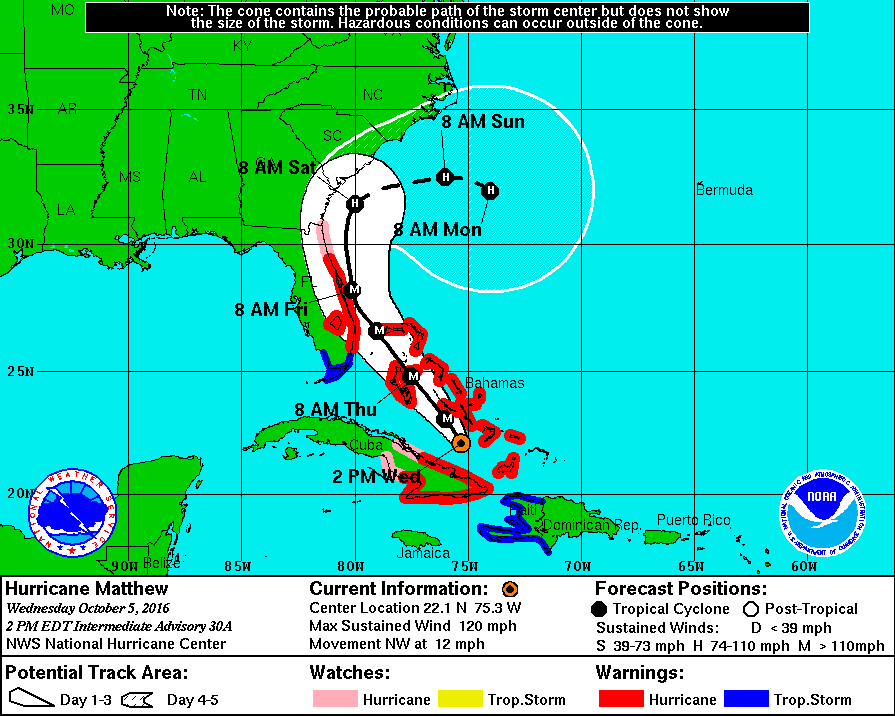From the ARRL, original post here. 10/05/2016
[UPDATED 2016-10-05 @1832 UTC] Amateur Radio Emergency Service (ARES) groups in counties along Florida’s east coast are now at a Level 2 (local) activation for Hurricane Matthew. A Level 1 (statewide) declaration is expected by Thursday, October 6, according to Northern Florida Section Manager Steve Szabo WB4OMM. He said The Statewide Amateur Radio Network (SARnet) will be activated on October 6 as well. SARnet is a network of linked UHF repeaters serving Florida. During a significant emergency, SARnet may be called upon for support through an official state emergency request.
Several US Eastern Seaboard states are ramping up plans to deal with the storm’s arrival. Florida and other coastal states already have issued evacuation orders for some counties, and Florida is bracing for a possible direct hit by Hurricane Matthew. The storm is reported to have caused at least 10 deaths in the Caribbean.
As of 1800 UTC, the National Hurricane Center (NHC) in Miami reported that Hurricane Matthew was about 70 miles north-northeast of Cabo Lucrecia, Cuba, and about 70 miles south of Long Island in the Bahamas. The storm is packing maximum sustained winds of 120 MPH and is moving northwest at 12 MPH. After slamming Haiti, the storm’s intensity diminished to category 3. Hurricane and tropical storm watches and warnings are in effect for parts of Florida. The storm is expected to strengthen as it approaches the US, and its effects could last through the weekend.
Hurricane warnings are in effect for Broward, Palm Beach, Martin, St Lucie, Indian River, and Okeechobee Counties, along with Lake Okeechobee. A hurricane watch is in effect for Nassau, Duval, St Johns, Flagler, Clay, Putnam, Volusia, Brevard, Osceola, Orange, and Seminole Counties. Tropical storm warnings have been posted for Miami-Dade, Monroe, Collier, Hendry, and Glades Counties. A tropical storm watch remains in effect for Lake, Sumter, Polk, Highlands, Marion, Union, Bradford, Baker, and Alachua Counties.
“Interests elsewhere in the Florida Peninsula and the Florida Keys should monitor the progress of Matthew,” the NHC said. The storm remains more than 400 miles southeast of Miami Beach. Emergency operations centers in Daytona Beach and in Volusia County are on partial activation. The Florida State EOC is monitoring.
National SATERN Liaison Bill Feist, WB8BZH, reported today that Haiti was hit hard by Hurricane Matthew, and SATERN has been in touch with Jean-Robert Gaillard, HH2JR, in Port au Prince, who said southern Haiti was “in bad shape.” More than 500 Cuban radio amateurs have been reported active in the eastern provinces, with operation on 2, 40, and 80 meters. Poor propagation has prevented some stations from checking into the Hurricane Watch Net (HWN). The net has been attempting to obtain post-storm reports from Haiti.
The Hurricane Watch Net remains active on 14.325 and 7.268 MHz to gather real-time “ground truth” weather data and storm-related information from affected areas. The net relays the information it gathers to forecasters via WX4NHC at the National Hurricane Center.
The VoIP Hurricane Net is also supporting the NHC on the WX-Talk Conference, Node #7203 on Echolink and IRLP Reflector 9219. IRLP Reflector 9553 is the backup. This net will also be analyzing social media from the impacted areas and Internet website data from sites such as the Caribbean Hurricane Network.
Matthew is a very large storm with the potential to generate gusty winds and rough seas along Florida’s east coast, as well as minor coastal flooding, beach erosion, and dangerous rip currents. Areas along the east coast of Florida — from Miami to Jacksonville and inland to Orlando — have a greater than 70 percent chance of tropical storm force winds within the next 3 days, while areas from Fort Pierce to West Palm Beach have a 90 percent or greater chance of tropical storm force winds.
Hurricane force winds will be just off the coast of Florida, and any westward deviation of the current track will bring those destructive hurricane force winds onshore. Heavy rainfall and storm surges could result. Evacuation shelters are on standby in some Florida counties, if they are needed.
The Salvation Army Team Emergency Radio Network (SATERN) will remain active at a DELTA II (extended monitoring) status on 14.265 MHz, immediately following the conclusion of the International SATERN SSB Net each day at least through Friday, October 7. This will include continuous monitoring of the net frequency of 14.265 MHz while propagation lasts.
ARRL Emergency Preparedness Manager Mike Corey, KI1U, reports that the current focus of ARRL is to continue to assist Cuba, Haiti, and Jamaica with keeping their emergency frequencies clear. As yet, there are no plans to activate W1AW, although that could change. The ARRL has been in touch with Field Organization volunteers in the US Virgin Islands and along the US Eastern Seaboard and will respond according to their needs.
The ARRL Headquarters Emergency Response Team is currently in monitoring phase and will go to stand-by status on Thursday, October 6.
IARU Region 2, Area C Emergency Coordinator Arnie Coro, CO2KK, reports that Amateur Radio equipment is being dispersed throughout eastern Cuba for emergency communication on 80 and 40 meters. Frequencies in use in Cuba include 7.110 MHz (primary) and 7.120, 7.045, and 7.080 as alternates 1, 2, and 3, respectively.
The IARU Region 2 emergency Center of Activity frequencies are 3.750 MHz and 7.060 MHz.
All radio amateurs are asked to avoid transmitting on or near any emergency net frequencies. In addition, stations should not check into any emergency or weather information net unless they have something to contribute. In all cases, follow the instructions of the net control station. — Thanks to Mike Corey, KI1U, Bill Feist, WB8BZH, National SATERN Liaison

